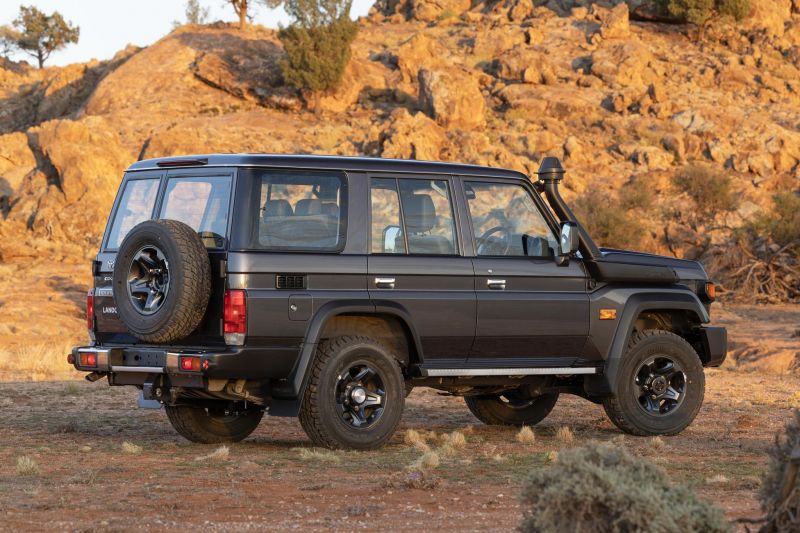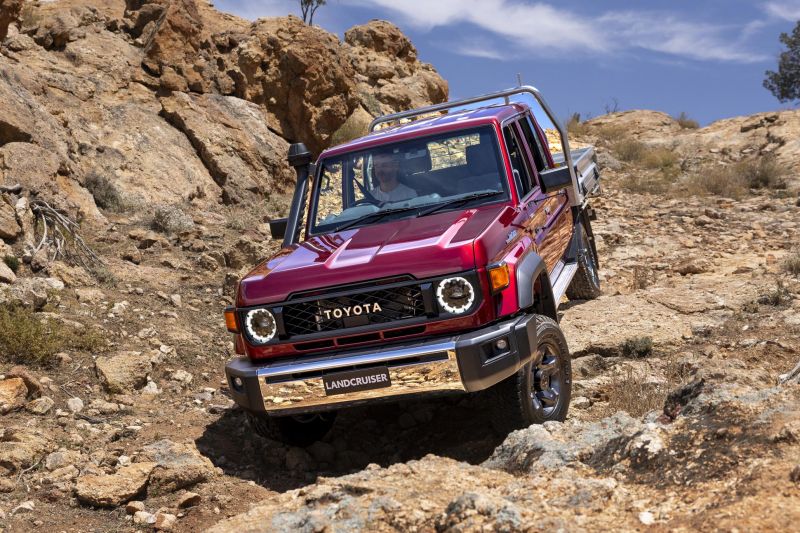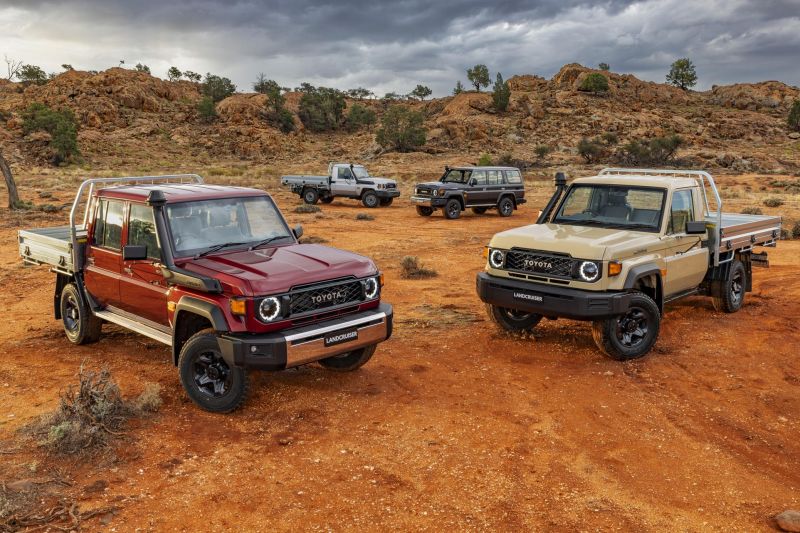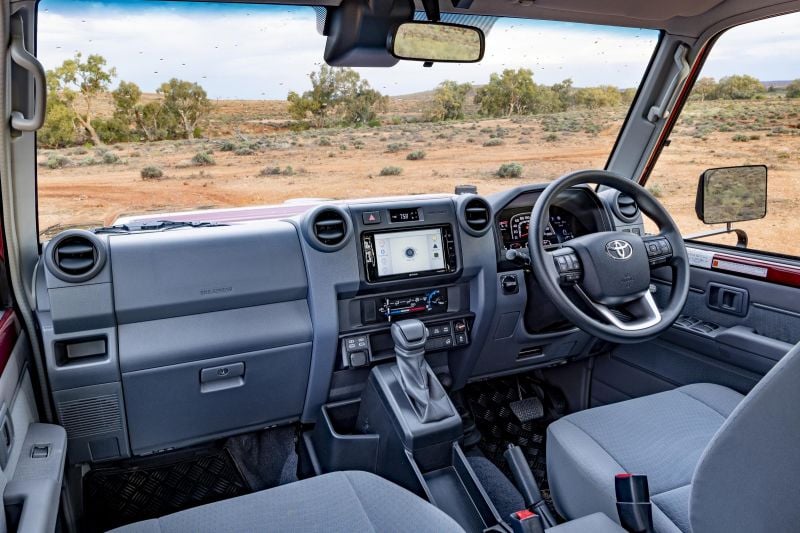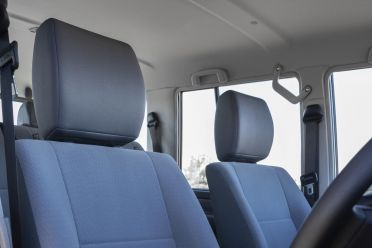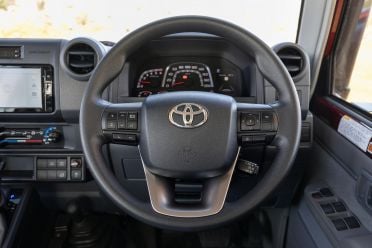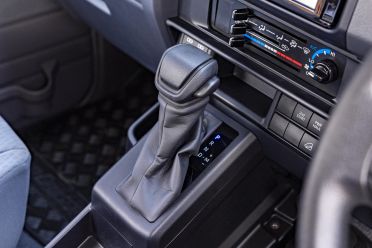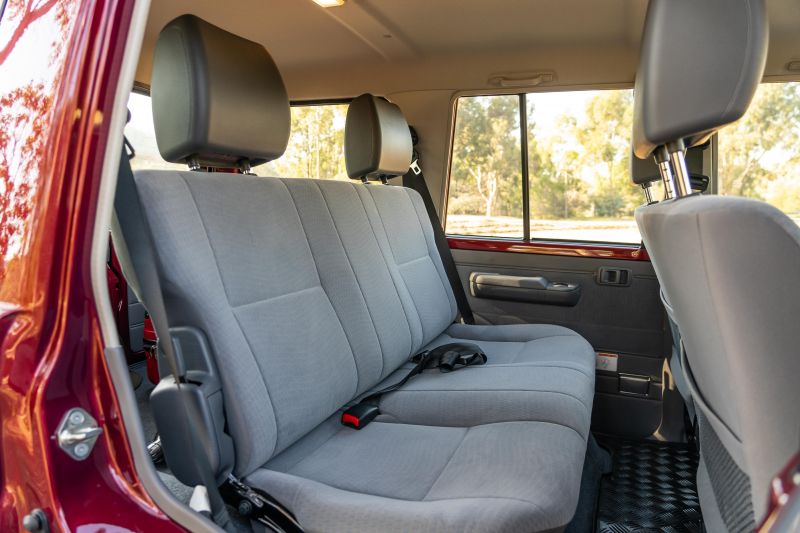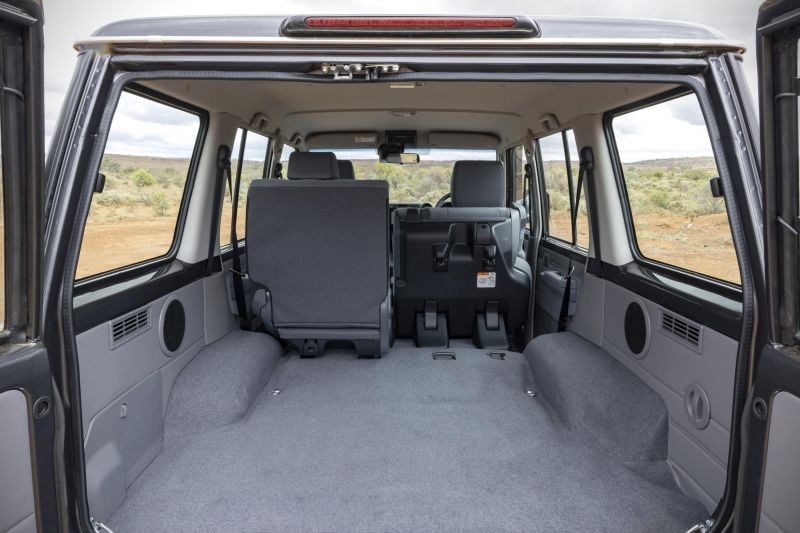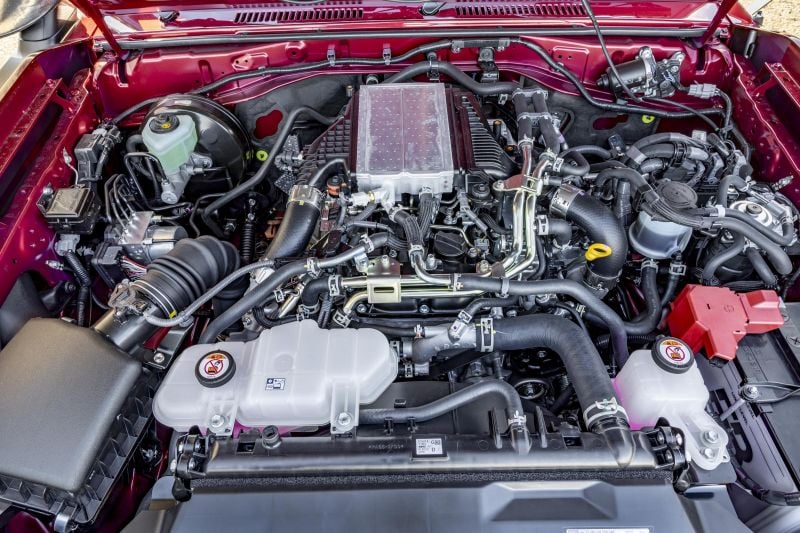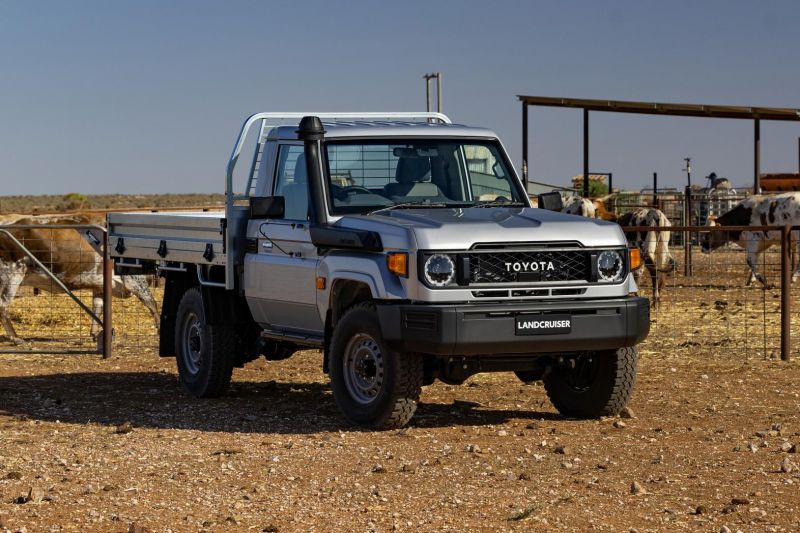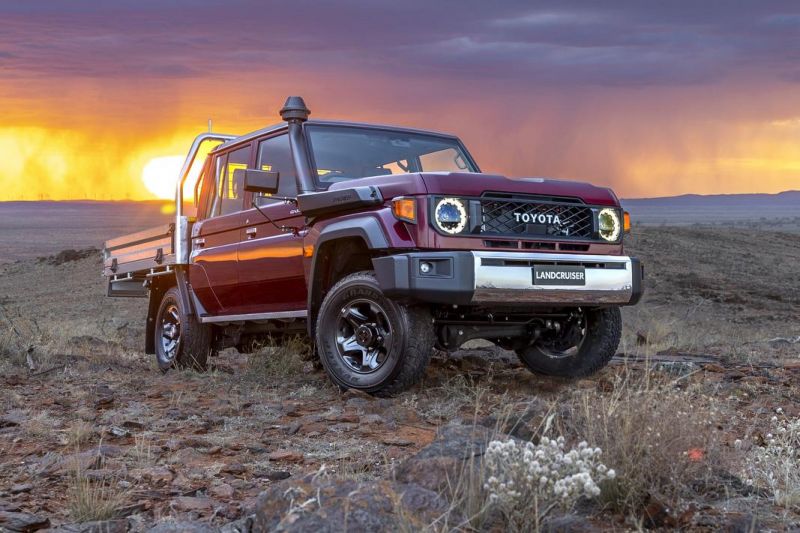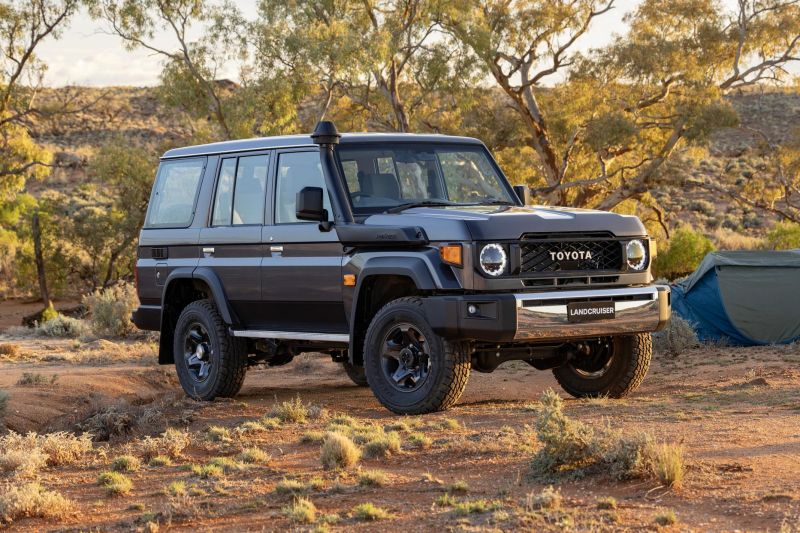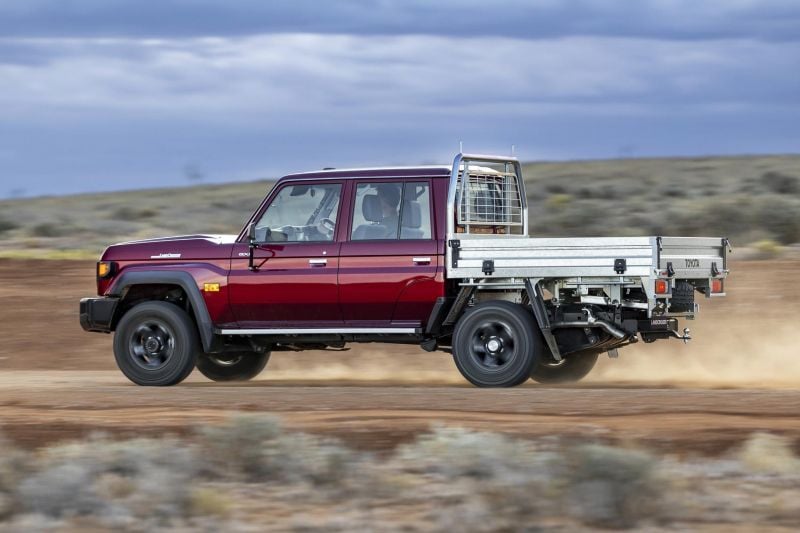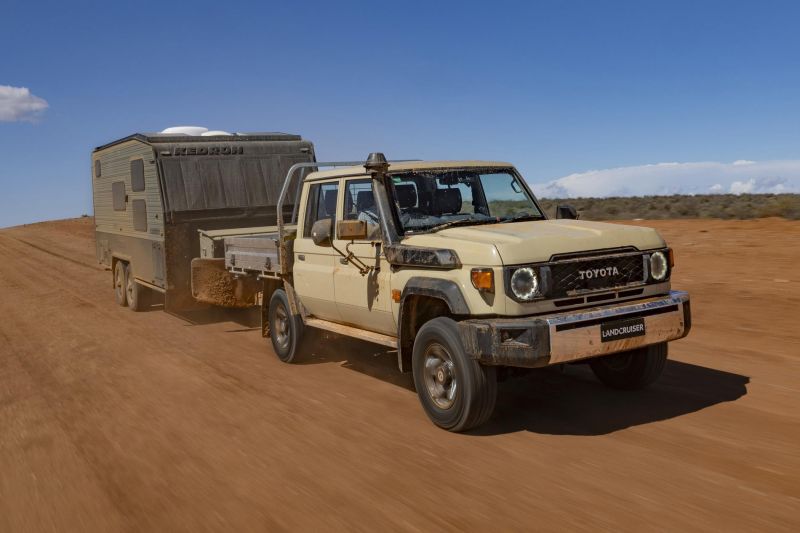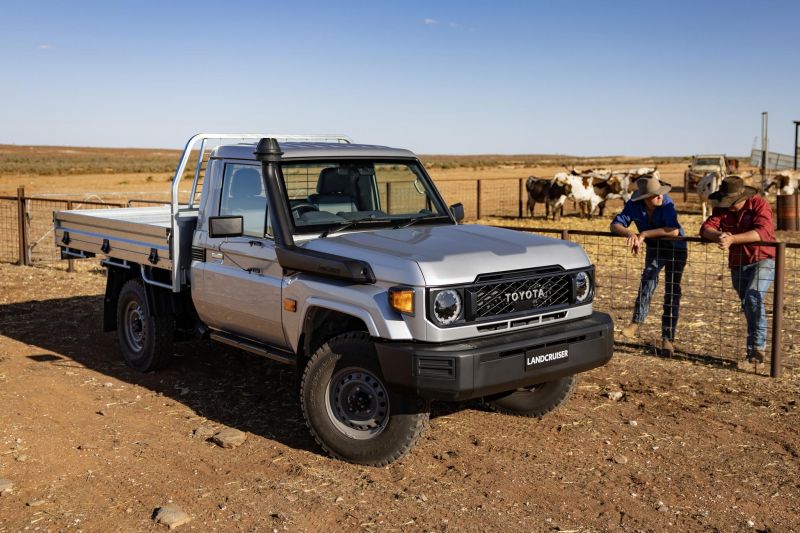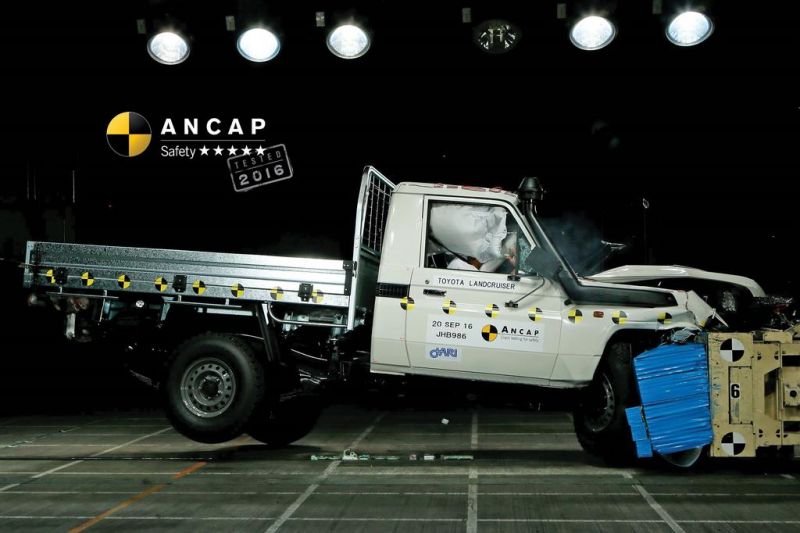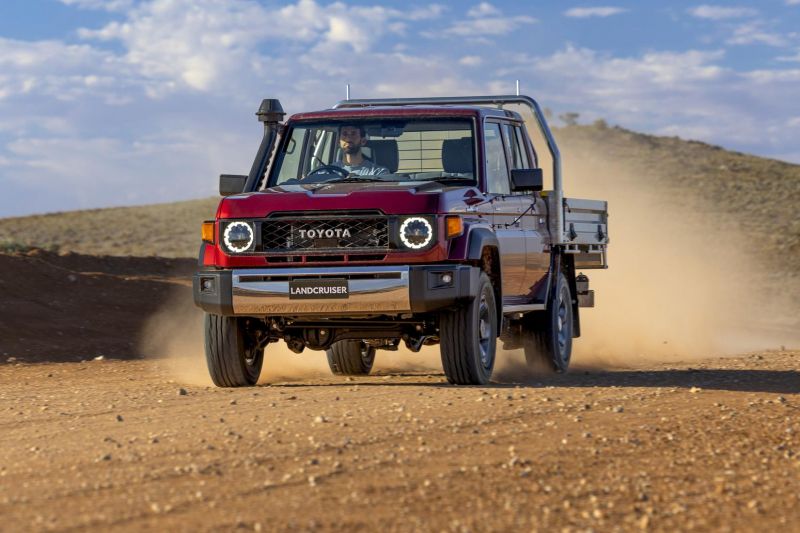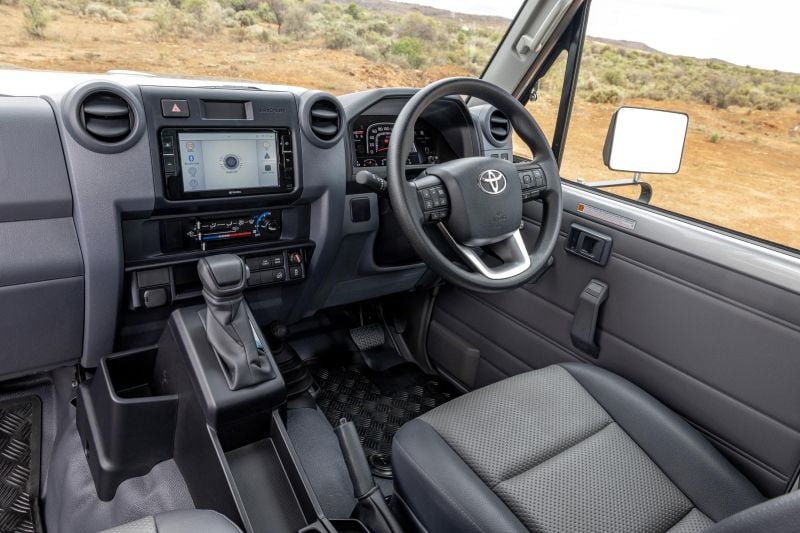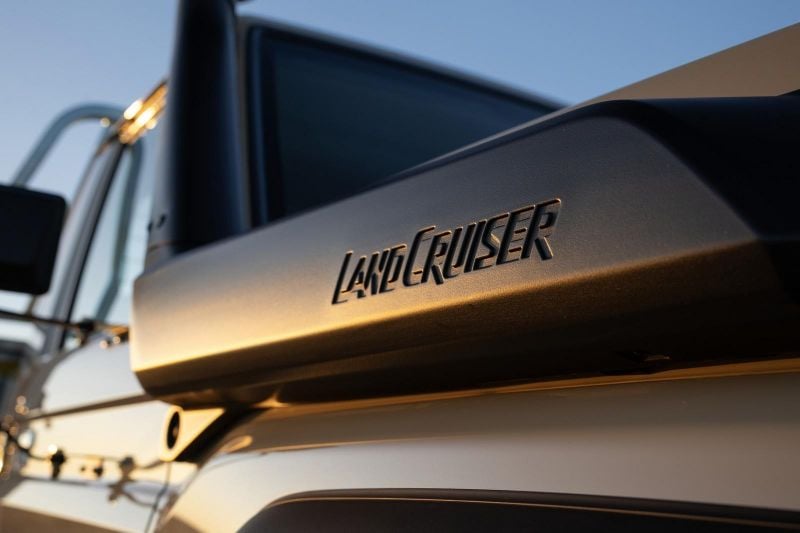Toyota has finally gone and done it.
The Toyota LandCruiser 70 Series has seldom been offered with an automatic from the factory (it has happened before though), and it’s been a V8 in Australia since 2007. Any change to the formula is keenly studied by its owners married to its no-nonsense brand of motoring, either
Although it’s been gradually evolved since its debut in 1984, a huge part of the LC70’s appeal is just how old-school it is. It’s a time machine on wheels, with only cursory nods to the safety, convenience, and comfort features that are now standard on even basic dual-cab utes and four-wheel drives.
Halving the cylinder count on any car is going to raise some eyebrows; doing it to an icon like the LandCruiser 70 – which in V8 form has waiting lists so long some dealers were telling potential buyers they’ll be waiting between two years and forever for a new car – is a big story no matter which way you spin it.
Approved by Japanese executives in 2019, the four-pot LC70 automatic comes on the back of “strong demand” from customers “because it makes the vehicle so much easier to handle for conditions such as towing trailers through sandy deserts”.
Along with the new engine, the updated LC70 has picked up lane departure warning, speed sign recognition and automatic high-beam. This follows the standardisation of autonomous emergency braking (AEB) with pedestrian and cyclist detection across the range for 2023.
It’s a comprehensive update given how slowly things change in the LandCruiser 70 world.
We headed to outback New South Wales to see if Toyota has taught been successful in its attempts to teach its oldest dog a few new tricks.

How much does the Toyota LandCruiser 70 cost?
2.8-litre four-cylinder turbo-diesel
- LandCruiser 76 Series Wagon WorkMate: $75,600
- LandCruiser 76 Series Wagon GXL: $79,800
- LandCruiser 78 Series Troop Carrier WorkMate: $79,200
- LandCruiser 78 Series Troop Carrier WorkMate: $82,500
- LandCruiser 79 Series single-cab chassis WorkMate: $76,800
- LandCruiser 79 Series single-cab chassis GX: $78,800
- LandCruiser 79 Series single-cab chassis GXL: $80,900
- LandCruiser 79 Series double-cab chassis WorkMate: $79,300
- LandCruiser 79 Series double-cab chassis GXL: $83,500
4.5-litre V8 turbo-diesel
- LandCruiser 76 Series Wagon GXL: $83,900
- LandCruiser 78 Series Troop Carrier WorkMate: $83,300
- LandCruiser 78 Series Troop Carrier GXL: $86,600
- LandCruiser 79 Series single-cab chassis WorkMate: $80,900
- LandCruiser 79 Series single-cab chassis GX: $82,900
- LandCruiser 79 Series single-cab chassis GXL: $85,000
- LandCruiser 79 Series double-cab chassis WorkMate: $83,400
- LandCruiser 79 Series double-cab chassis GXL: $87,600
All prices are before on-road costs.
The LandCruiser 70 has a limited selection of rivals, but they are out there. You can build your own side-by-side pricing chart using our new comparison function.
What is the Toyota LandCruiser 70 like on the inside?
The changes inside are subtle, as you’d expect.
The new bits are the retro-inspired dashboard – which now features a decidedly modern digital trip computer, complete with a digital speedo. There are also two USB-C ports in the GXL, a redesigned transmission console in the automatic, and a new infotainment touchscreen complete with Apple CarPlay and Android Auto.
Anyone who’s driven the manual will appreciate the extra knee room afforded by the death of the clutch pedal; it’s easier for long-legged drivers to get settled in and the footrest is more prominent.
The extra USB ports are welcome, and smartphone mirroring means you don’t need to mess around with what otherwise feels like quite an aftermarket head unit.
The driver and passenger sit in flat chairs trimmed in soft, velour-like cloth, and the driving position is properly old-school. Adjustment is limited for tall drivers, although the steering wheel does adjust for reach and rake. You can get comfortable, but this is not the most natural car for long stints behind the wheel if you’re awkwardly proportioned.
Storage is limited by modern standards. There’s slim door pockets and a small space between the front seats, but that’s about the extent of it. Thankfully the glovebox is relatively spacious.
Rear passengers get decent legroom, even behind taller drivers, and plenty of headroom from the tall, boxy roofline. The view out is positively panoramic thanks to the tall, square windows in both the wagon and dual-cab ute.
It’s worth noting the rear doors on the dual-cab ute don’t open particularly wide, so if you are loading apprentices in they’ll need to be limber.
The counter to the decent space on offer is the fact the windows aren’t tinted and there’s no air vents back there, turning the car into something of a greenhouse on a sunny day.
The LC70 is also the one of the few cars on sale we’ve seen with a lap belt for the middle passenger.
Top-tether points are on the roof in the wagon, but aren’t fitted to the rear of the dual-cab ute. The single cab, of course, doesn’t have any top-tether points given it doesn’t have rear seats.
The rear bench backrest folds and the whole row tumbles forward as one piece in the wagon, and can now be tumbled in the ute to free up more storage space.
Opening the boot (through side-opening barn doors) reveals a broad space with some (minimal) wheel arch intrusion.
As you can see from the images, the spare wheel is mounted on the tailgate old-school style. In ute versions, it’s on a convenient tray that slides out from beneath the tub.
What’s under the bonnet?
Almost all variants can be had with the new to the LC70, but“tried-and-tested” elsewhere 1GD-FTV 2.8-litre four-cylinder turbo-diesel engine which produces 150kW of power and 500Nm of torque. This is mated exclusively to a six-speed automatic transmission.
The other available powertrain is the familiar 1VD-FTV 4.5-litre V8 turbo-diesel engine which produces 151kW of power and 430Nm of torque. This is mated exclusively to a five-speed manual transmission.
All LandCruiser 70 Series models come with a part-time four-wheel drive system with a low-range transfer case. Locking front and rear differentials are available on GX models and standard on GXL models.
Claimed fuel economy is 9.6 litres per 100km on the combined cycle in the four-cylinder, and 10.7 litres per 100km in the V8.
Single-cab chassis
| GX | Workmate | GXL | |
|---|---|---|---|
| Length | 5235mm | 5235mm | 5245mm |
| Width | 1870mm | 1790mm | 1870mm |
| Height | 1955mm | 1970mm | 1955mm |
| Wheelbase | 3180mm | 3180mm | 3180mm |
| Front track | 1555mm | 1515mm | 1555mm |
| Rear track | 1460mm | 1420mm | 1460mm |
| Front overhang | 850mm | 850mm | 860mm |
| Rear overhang | 1190mm | 1190mm | 1190mm |
| Approach | 33 degrees | 35 degrees | 33 degrees |
| Departure | 27 degrees | 29 degrees | 27 degrees |
| Ground clearance | 316mm | 330mm | 316mm |
| Max kerb weight (i4-V8) | 2130-2190kg | 2145-2190kg | 2130-2195kg |
| Payload (i4-V8) | 1380-1320kg | 1365-1305kg | 1380-1315kg |
| Towing (unbraked-braked) | 750-3500kg | 750-3500kg | 750-3500kg |
| GVM | 3510kg | 3510kg | 3510kg |
Double-cab chassis
| Workmate | GXL | |
|---|---|---|
| Length | 5235mm | 5245mm |
| Width | 1790mm | 1870mm |
| Height | 1960mm | 1945mm |
| Wheelbase | 3180mm | 3180mm |
| Front track | 1515mm | 1555mm |
| Rear track | 1420mm | 1460mm |
| Front overhang | 850mm | 860mm |
| Rear overhang | 1190mm | 1190mm |
| Approach | 35 degrees | 33 degrees |
| Departure | 29 degrees | 27 degrees |
| Ground clearance | 317mm | 302mm |
| Max kerb weight (i4-V8) | 2200-2260kg | 2185-2240kg |
| Payload (i4-V8) | 1365-1305kg | 1380-1315kg |
| Towing (unbraked-braked) | 750-3500kg | 750-3500kg |
| GVM | 3510kg | 3510kg |
Wagon
| Workmate | GXL | |
|---|---|---|
| Length | 4865mm | 4910mm |
| Width | 1800mm | 1870mm |
| Height | 1955mm | 1940mm |
| Wheelbase | 3180mm | 3180mm |
| Front track | 1515mm | 1555mm |
| Rear track | 1420mm | 1460mm |
| Front overhang | 850mm | 860mm |
| Rear overhang | 1285mm | 1320mm (i4) – 1285mm |
| Approach | 35 degrees | 33 degrees |
| Departure | 25 degrees | 23 degrees |
| Ground clearance | 305mm | 290mm |
| Max kerb weight (i4-V8) | 2320kg | 2300-2355kg |
| Payload (i4-V8) | 1190kg | 1210-1155kg |
| Towing (unbraked-braked) | 750-3500kg | 750-3500kg |
| GVM | 3510kg | 3510kg |
How does the Toyota LandCruiser 70 drive?
It’s strange not stepping on a heavy clutch and muscling the long, old-fashioned gear selector into first gear (or second, depending on your mood) to get going in a 70 Series.
That’s not the only core trait that’s changed. The four-cylinder is quieter than the big V8, and it’s much smoother at low speeds. You can just point and shoot at city speeds, concentrating on threading what’s a big old bus with heavy, vague steering through more modern traffic.
Even in undemanding circumstances, removing the third pedal frees up a surprising amount of brain power. Put your foot down, and the engine – which is familiar from the HiLux, Fortuner, Prado, and HiAce – packs a decent punch, dragging more than two tonnes worth of LandCruiser up to the legal limit without too much fuss.
It’s spinning at around 2000rpm at 110km/h, and eats up highway overtakes thanks to a six-speed automatic that’s happy to kick down from sixth and thrust the engine into the meat of its torque band. No, it’s not fast. Yes, it’s easier to go as fast as such a heavy, un-aerodynamic body will allow in the four-cylinder.
With that said, even on the road there’s a certain charm about the V8. It’s delightfully old school, with a gruff sound and plenty of vibrations in the cabin, while the transmission demands deliberate, firm movements. At least there’s enough torque on tap to essentially move away in first, second, or third gear.
We didn’t spend much time in the city, given our drive kicked off in Broken Hill. But at any speed, the LandCruiser 70 doesn’t ride like a modern ute or four-wheel drive.
It’s pretty terse, and is prone to bouncing around at highway speeds over the crests, dips, and cattle grids littering outback Australia. The solid front axle likes going for a wander with cambered roads, and even with lane departure warning you’ll need to have your wits about you in a way you don’t with a HiLux or Ranger.
The payoff, of course, is when you get off the beaten track. Along with the requisite 2H, 4H, 4L transfer case (operated with a lever rather than a new-school dial), you get at least one locking differential, and a set of locking hubs on the front axles. There’s around 90mm more ground clearance than you get in a HiLux, and the solid front axle opens doors usually shut by a dual-cab ute’s independent front suspension.
As is the case on the road, the four-cylinder feels every bit as capable as the V8 in the offset moguls and rock crawl we took on, but is far easier to drive. It’s easier to be smooth over awkward obstacles, and even though the 4.5-litre V8 has enough torque to essentially stop dead in low-range without stalling, there still comes a point where you’ll need to get your left leg involved.
In the automatic, you can just hover over the brake and let the car crawl along without the same stress. The 70 Series walked through all the off-roading challenges we threw at it, which isn’t unusual on a launch. Toyota did really stretch its legs though, with one of its most senior test drivers behind the wheel and a pretty serious rock face.
The capability baked into a stock LandCruiser 70 is pretty staggering, let alone one which has been fettled by the aftermarket. After 39 years though, we already knew that.
With that said, the wider front track that’s been around since 2007 remains an impediment when you’re traversing soft surfaces, forcing you to work harder by forging two paths instead of letting the rear tyres follow in the same track as the fronts. Unfortunately, you’ll need to turn to the aftermarket and dig deep into your pockets to get that sorted.
Along with off-roading and “no road” situations, Toyota points to towing through tough environments as a key marker for the LandCruiser 70 in its development. To show off what that looks like, the brand hooked up a 3100kg caravan and let us loose on a short gravel and tarmac loop.
Body control is solid with such a heavy load on the back, with our dual-cab tester settling in one or two movements rather than bouncing around, and both engines have enough punch to pull the caravan and three adult blokes uphill without feeling overly strained.
In keeping with the theme laid out by the rest of the range, the four-cylinder doesn’t feel under-gunned alongside the 4.5-litre V8. The extra gear, combined with the impact of the torque converter on the engine’s outputs, mean the new 2.8-litre is easier to drive smoothly with a load on the back.
It pulls just as hard uphill, and you’re able to lock it into tow/haul mode for keener response between 0 and 75 per cent throttle. Of course, there’s still something deeply satisfying about muscling the manual around…
What do you get?
The 2024 Toyota LandCruiser WorkMate comes standard with the following features:
- LED headlights
- Automatic high-beam
- Black mesh grille
- Heritage-inspired bonnet
- Heritage-inspired turn signals
- Steel side steps
- 4.2-inch instrument cluster screen
- 6.7-inch touchscreen infotainment system
- Wired Apple CarPlay and Android Auto
- Voice recognition
- Two-speaker sound system
- Centre storage box (automatic variants only)
- Vinyl upholstery
The 79 Series GX single-cab chassis adds dark alloy wheels and overfenders.
The LandCruiser GXL variants add:
- LED front fog lights
- Chrome and painted front bumper (79 Series ute only)
- Moulded black front and rear bumpers (Wagon and Troop Carrier only)
- Aluminium side steps
- Chrome roof drip rails
- Four-speaker sound system (exc. single-cab ute)
- Two USB-C ports (in place of 12V socket)
- Driver and front passenger map pockets
- Cloth upholstery
The Toyota LandCruiser 79 GX single-cab chassis is available with front and rear differential locks for an additional $1500.
Is the Toyota LandCruiser 70 safe?
The LandCruiser 70 Series was tested by ANCAP back in 2016 and received five stars, however this was for the single cab-chassis variant only.
It received a front offset score of 14.75 out of 16, a side impact score of 16 out of 16, a pole score of 2 out of 2, and a seat belt reminder score of 3 out of 3.
Standard safety equipment includes:
- Autonomous emergency braking (AEB)
- Lane departure warning
- Traffic sign recognition
The 76 Series Wagon adds a reversing camera.
How much does the Toyota LandCruiser 70 cost to run?
The Toyota LandCruiser 70 Series has the same five-year, unlimited-kilometre warranty as the broader Toyota range, extended to seven years on the powertrain if you keep up with the scheduled services.
Maintenance is required every 10,000km or six months, whichever comes first. For a car that’s relied upon by so many, having to visit your dealership twice yearly is a big miss.
The first 10 services each cost $525 in the both models.
CarExpert’s Take on the Toyota LandCruiser 70
Whether you want the long-running V8 engine, or whether you’ll jump to the new four-cylinder comes down to how you plan to use the LC70.
There’s a strong cult of enthusiasts who want a 70 to relive times gone by, and they’re only going to want the V8 with its retro-tastic five-speed manual transmission. It’s a more charming, engaging car to drive than the four-cylinder… but it’s not a better one.
It’s going to take a while for the new 1GD engine to prove itself reliable to the legion of remote workers who rely on their LandCruiser 70, but it’ll only take one spin around the block to realise how much easier it makes life.
Based on our back-to-back on-road, off-road, and towing loops, the four-cylinder wants for nothing when it comes to outright capability.
That might be selling it short; the extra gear you get by opting for the automatic, along with the four-cylinder engine’s broader torque band, do an exceptional job disguising the fact it’s 1700cc down on the V8, to the point you could easily trick people into thinking it was the bigger engine.
Throw in the fact it’s going to be easier for fleet controllers to sell to their legal departments thanks to its lower claimed fuel economy, cheaper sticker, and automatic transmission, and it’s hard to see why you’d stick with the V8 engine if you’re not an out-and-out enthusiast.
As for the rest of the LandCruiser 70 update? It’s still a time machine on wheels – from the second you unlatch the metal door handle, clamber onto the velour seat, and survey the outback through its upright windscreen, there’s nothing else you could be driving, for better or worse.
Click the images for the full gallery
BUY: Toyota LandCruiser 70 Series
MORE: Everything Toyota LandCruiser 70 Series





